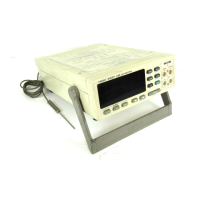6
────────────────────────────────────────────────────
1.3 Measurements and Working Systems
────────────────────────────────────────────────────
.3 Measurements and Working Systems
Regular 2-terminal measurement measures even the value which includes the
resistance of the measurement leads or the terminal area. Particularly, when
measuring the low resistance, it is necessary to measure the value without
this resistance value. 4-terminal measurement is able to measure that value.
4-terminal measurement and 2-terminal measurement are explained as
follows. In the figure below, there is very big input impedance in the
voltmeter, and all of the current I flows to the measured resistance R
0
. The r
1
to r
4
means the resistance of the measurement leads or the contact resistance
of the terminal area.
All of the current I flows to the measured resistance R
0
. Therefore, the
voltage drop of r
3
and r
4
become 0, and voltage E and the voltage drop E
0
of
each end of the measured resistance R
0
become equal. Accordingly, the
resistance measurement without influence of r
1
to r
4
becomes possible.

